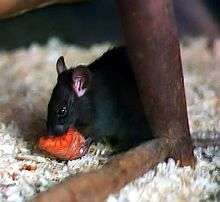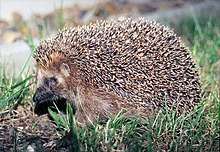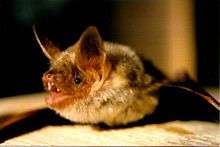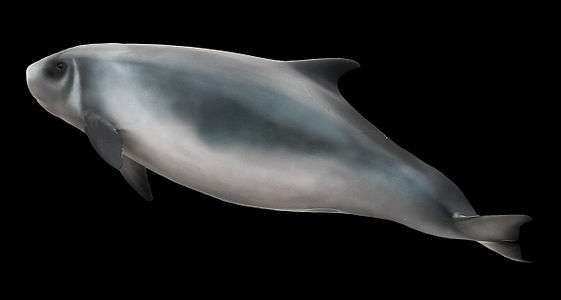List of mammals of the Azores
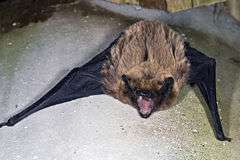
This is a list of the mammal species recorded in the Azores Islands, Portugal.[1] One of the most remote archipelagos in Europe, the Azores were completely devoid of mammals prior to their discovery in the early 15th century, except for marine mammals and two species of bats, and all present terrestrial mammals in the islands are therefore introduced.
The following tags are used to highlight each species' conservation status as assessed by the IUCN.
| EX | Extinct | No reasonable doubt that the last individual has died. |
| EW | Extinct in the wild | Known only to survive in captivity or as a naturalized populations well outside its previous range. |
| CR | Critically endangered | The species is in imminent risk of extinction in the wild. |
| EN | Endangered | The species is facing an extremely high risk of extinction in the wild. |
| VU | Vulnerable | The species is facing a high risk of extinction in the wild. |
| NT | Near threatened | The species does not meet any of the criteria that would categorise it as risking extinction but it is likely to do so in the future. |
| LC | Least concern | There are no current identifiable risks to the species. |
| DD | Data deficient | There is inadequate information to make an assessment of the risks to this species. |
Subclass: Theria
Infraclass: Eutheria
Order: Rodentia (rodents)
Rodents make up the largest order of mammals, with over 40 percent of mammalian species. They have two incisors in the upper and lower jaw which grow continually and must be keep short by gnawing. Most rodents are small though the capybara can weigh up to 45 kg (100 lb).
- Suborder: Sciuromorpha
- Suborder: Myomorpha
Order: Erinaceomorpha (hedgehogs and gymnures)
The order Erinaceomorpha contains a single family, Erinaceidae, which comprise the hedgehogs and gymnures. The hedgehogs are easily recognised by their spines while gymnures look more like large rats.
- Family: Erinaceidae (hedgehogs)
- Subfamily: Erinaceinae
- Genus: Erinaceus
- European hedgehog Erinaceus europaeus LC introduced
- Genus: Erinaceus
- Subfamily: Erinaceinae
Order: Chiroptera (bats)
The bats' most distinguishing feature is that their forelimbs are developed as wings, making them the only mammals in the world naturally capable of flight. Bat species account for about 20% of all mammals.
- Family: Vespertilionidae (mouse-eared bats)
- Subfamily: Myotinae
- Genus: Myotis
- Greater mouse-eared bat Myotis myotis LC
- Genus: Myotis
- Subfamily: Verpertilioninae
- Genus: Nyctalus
- Azores noctule Nyctalus azoreum VU
- Genus: Nyctalus
- Subfamily: Myotinae
Order: Cetacea (whales)


The order Cetacea includes whales, dolphins and porpoises. They are the mammals most fully adapted to aquatic life with a spindle-shaped nearly hairless body, protected by a thick layer of blubber, and forelimbs and tail modified to provide propulsion underwater. Many species of cetaceans reproduce around the Azores.
- Suborder: Mysticeti
- Family: Balaenidae
- Genus: Eubalaena
- North Atlantic right whale Eubalaena glacialis CR
- Genus: Eubalaena
- Family: Balaenopteridae (rorquals)
- Genus: Balaenoptera
- Northern minke whale Balaenoptera acutorostrata LC
- Sei whale Balaenoptera borealis EN
- Blue whale Balaenoptera musculus EN
- Fin whale Balaenoptera physalus NT
- Genus: Megaptera
- Humpback whale Megaptera novaeangliae LC
- Genus: Balaenoptera
- Family: Balaenidae
- Suborder: Odontoceti
- Family: Delphinidae (dolphins and pilot whales)
- Genus: Delphinus
- Short-beaked common dolphin Delphinus delphis DD vagrant
- Genus: Globicephala
- Short-finned pilot whale Globicephala macrorhyncus DD
- Long-finned pilot whale Globicephala melas DD
- Genus: Grampus
- Risso's dolphin Grampus griseus DD
- Genus: Orcinus
- Killer whale Orcinus orca DD
- Genus: Pseudorca
- False killer whale Pseudorca crassidens DD vagrant
- Genus: Stenella
- Striped dolphin Stenella coeruleoalba DD
- Atlantic spotted dolphin Stenella frontalis DD
- Genus: Tursiops
- Common bottlenose dolphin Tursiops truncatus DD
- Genus: Delphinus
- Family: Kogiidae (small sperm whales)
- Genus: Kogia
- Pygmy sperm whale Kogia breviceps DD
- Dwarf sperm whale Kogia sima DD
- Genus: Kogia
- Family: Physeteridae (sperm whales)
- Genus: Physeter
- Sperm whale Physeter macrocephalus VU
- Genus: Physeter
- Family: Ziphiidae (beaked whales)
- Genus: Hyperoodon
- Northern bottlenose whale Hyperoodon ampullatus DD
- Genus: Mesoplodon
- Sowerby's beaked whale Mesoplodon bidens DD
- Blainville's beaked whale Mesoplodon densirostris DD
- Gervais' beaked whale Mesoplodon europaeus DD
- True's beaked whale Mesoplodon mirus DD
- Genus: Ziphius
- Cuvier's beaked whale Ziphius cavirostris DD
- Genus: Hyperoodon
- Family: Delphinidae (dolphins and pilot whales)
Order: Carnivora (carnivorans)
There are over 260 species of carnivorans, the majority of which feed primarily on meat. They have a characteristic skull shape and dentition.
- Suborder: Caniformia
- Family: Mustelidae (mustelids)
- Genus: Mustela
- Least weasel Mustela nivalis LC
- Genus: Mustela
- Family: Phocidae (earless seals)
- Genus: Monachus
- Mediterranean monk seal Monachus monachus EX
- Genus: Monachus
- Family: Mustelidae (mustelids)
Notes
- ↑ The taxonomy and naming of the individual species is based on those used in existing Wikipedia articles as of 9 January 2013 and supplemented by the common names and taxonomy from the IUCN where no Wikipedia article was available.
References
- Aulagnier, S. et al. (2008) Guide des mammifères d'Europe, d'Afrique du Nord et de Moyen-Orient. Delachaux et Niestlé, Paris
- Shirihai, H. & Jarrett, B. (2006) Whales, dolphins and seals: A field guide to the marine mammals of the world. A & C Black, London
